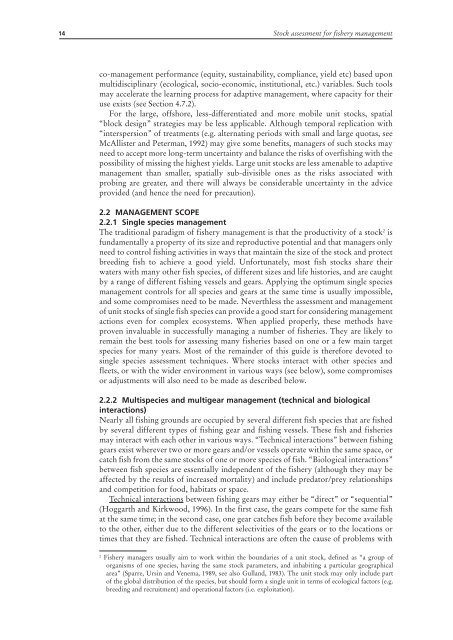Stock assessment for fishery management - Library
Stock assessment for fishery management - Library
Stock assessment for fishery management - Library
You also want an ePaper? Increase the reach of your titles
YUMPU automatically turns print PDFs into web optimized ePapers that Google loves.
14 <strong>Stock</strong> <strong>assessment</strong> <strong>for</strong> <strong>fishery</strong> <strong>management</strong>co-<strong>management</strong> per<strong>for</strong>mance (equity, sustainability, compliance, yield etc) based uponmultidisciplinary (ecological, socio-economic, institutional, etc.) variables. Such toolsmay accelerate the learning process <strong>for</strong> adaptive <strong>management</strong>, where capacity <strong>for</strong> theiruse exists (see Section 4.7.2).For the large, offshore, less-differentiated and more mobile unit stocks, spatial“block design” strategies may be less applicable. Although temporal replication with“interspersion” of treatments (e.g. alternating periods with small and large quotas, seeMcAllister and Peterman, 1992) may give some benefits, managers of such stocks mayneed to accept more long-term uncertainty and balance the risks of overfishing with thepossibility of missing the highest yields. Large unit stocks are less amenable to adaptive<strong>management</strong> than smaller, spatially sub-divisible ones as the risks associated withprobing are greater, and there will always be considerable uncertainty in the adviceprovided (and hence the need <strong>for</strong> precaution).2.2 MANAGEMENT SCOPE2.2.1 Single species <strong>management</strong>The traditional paradigm of <strong>fishery</strong> <strong>management</strong> is that the productivity of a stock 2 isfundamentally a property of its size and reproductive potential and that managers onlyneed to control fishing activities in ways that maintain the size of the stock and protectbreeding fish to achieve a good yield. Un<strong>for</strong>tunately, most fish stocks share theirwaters with many other fish species, of different sizes and life histories, and are caughtby a range of different fishing vessels and gears. Applying the optimum single species<strong>management</strong> controls <strong>for</strong> all species and gears at the same time is usually impossible,and some compromises need to be made. Neverthless the <strong>assessment</strong> and <strong>management</strong>of unit stocks of single fish species can provide a good start <strong>for</strong> considering <strong>management</strong>actions even <strong>for</strong> complex ecosystems. When applied properly, these methods haveproven invaluable in successfully managing a number of fisheries. They are likely toremain the best tools <strong>for</strong> assessing many fisheries based on one or a few main targetspecies <strong>for</strong> many years. Most of the remainder of this guide is there<strong>for</strong>e devoted tosingle species <strong>assessment</strong> techniques. Where stocks interact with other species andfleets, or with the wider environment in various ways (see below), some compromisesor adjustments will also need to be made as described below.2.2.2 Multispecies and multigear <strong>management</strong> (technical and biologicalinteractions)Nearly all fishing grounds are occupied by several different fish species that are fishedby several different types of fishing gear and fishing vessels. These fish and fisheriesmay interact with each other in various ways. “Technical interactions” between fishinggears exist wherever two or more gears and/or vessels operate within the same space, orcatch fish from the same stocks of one or more species of fish. “Biological interactions”between fish species are essentially independent of the <strong>fishery</strong> (although they may beaffected by the results of increased mortality) and include predator/prey relationshipsand competition <strong>for</strong> food, habitats or space.Technical interactions between fishing gears may either be “direct” or “sequential”(Hoggarth and Kirkwood, 1996). In the first case, the gears compete <strong>for</strong> the same fishat the same time; in the second case, one gear catches fish be<strong>for</strong>e they become availableto the other, either due to the different selectivities of the gears or to the locations ortimes that they are fished. Technical interactions are often the cause of problems with2Fishery managers usually aim to work within the boundaries of a unit stock, defined as “a group o<strong>for</strong>ganisms of one species, having the same stock parameters, and inhabiting a particular geographicalarea” (Sparre, Ursin and Venema, 1989, see also Gulland, 1983). The unit stock may only include partof the global distribution of the species, but should <strong>for</strong>m a single unit in terms of ecological factors (e.g.breeding and recruitment) and operational factors (i.e. exploitation).
















